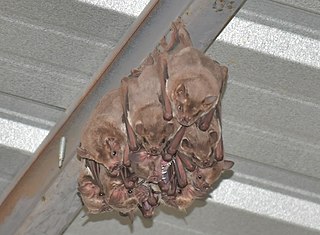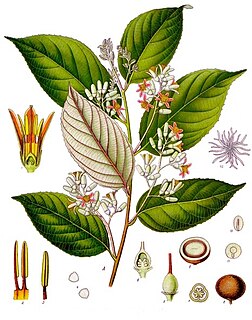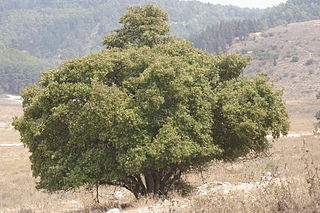
In polymer chemistry and materials science, resin is a solid or highly viscous substance of plant or synthetic origin that is typically convertible into polymers. Resins are usually mixtures of organic compounds. This article focuses on naturally occurring resins.
A calcifuge is a plant that does not tolerate alkaline (basic) soil. The word is derived from the Latin 'to flee from chalk'. These plants are also described as ericaceous, as the prototypical calcifuge is the genus Erica (heaths). It is not the presence of carbonate or hydroxide ions per se that these plants cannot tolerate, but the fact that under alkaline conditions, iron becomes less soluble. Consequently, calcifuges grown on alkaline soils often develop the symptoms of iron deficiency, i.e. interveinal chlorosis of new growth. There are many horticultural plants which are calcifuges, most of which require an 'ericaceous' compost with a low pH, composed principally of Sphagnum moss peat.

Styrax is a genus of about 130 species of large shrubs or small trees in the family Styracaceae, mostly native to warm temperate to tropical regions of the Northern Hemisphere, with the majority in eastern and southeastern Asia, but also crossing the equator in South America. The resin obtained from the tree is called benzoin or storax.

Benzoin or benjamin is a balsamic resin obtained from the bark of several species of trees in the genus Styrax. It is used in perfumes and some kinds of incense and as a flavoring and medicine. It is distinct from the chemical compound benzoin, which is ultimately derived chemically from benzoin resin; the resin, however, does not contain this compound.

The Styracaceae are a small family of flowering plants in the order Ericales, containing 12 genera and about 160 species of trees and shrubs. The family occurs in warm temperate and subtropical regions of the Northern Hemisphere.

The fraternal fruit-eating bat is a species of bat in the family Phyllostomidae that is found in drier habitats in Ecuador and Peru. It was formerly considered to be a subspecies of the Jamaican fruit bat, but was raised to species level in 1978. The smallest species in the group of large Artibeus, it has a forearm length of 52–59 mm (2.0–2.3 in), a total length of 64–76 mm (2.5–3.0 in), and a weight of 30–55 g (1.1–1.9 oz).

Helicia is a genus of 110 species of trees and shrubs, constituting part of the plant family Proteaceae. They grow naturally in rainforests throughout tropical South and Southeast Asia, including India, Sri Lanka, Indochina, Peninsular Malaysia to New Guinea and as far south as New South Wales.
Styrax vilcabambae is a species of flowering plant in the genus Styrax and the family Styracaceae. It is endemic to Peru.
Styrax crotonoides is a species of plant in the genus Styrax and family Styracaceae. It is found in Peninsular Malaysia and Singapore.
Styrax foveolaria is a species of tree in the family Styracaceae. It is native to Peru and Ecuador. It has been classified by the IUCN as a vulnerable species.
Styrax fraserensis is a species of flowering plant in the genus Styrax and family Styracaceae. It is a tree endemic to Peninsular Malaysia. It is threatened by habitat loss.
Styrax peruvianus is a species of tree in the family Styracaceae. It is found from Costa Rica south to Peru. It has been classified by the IUCN as a vulnerable species.

Styrax portoricensis, locally known as palo de jazmin, is a species of flowering plant in the family Styracaceae. It is endemic to Puerto Rico. It is one of the rarest endemic trees of Puerto Rico and is known to occur only in the northeastern Luquillo Mountains and the north-central Cayey Mountains.

El Toro Wilderness is a 10,254-acre (41.5 km2) federally designated National Wilderness Preservation System unit located within El Yunque National Forest on the Sierra de Luquillo in eastern Puerto Rico. El Toro, named after the highest peak in the forest at 3,524 feet (1,074 m), is the only tropical wilderness in the United States National Forest System. It was created in 2005 by the Caribbean National Forest Act of 2005.

Styrax benzoin is a species of tree native to Sumatra in Indonesia. Common names for the tree include gum benjamin tree, loban (in Arabic), kemenyan (in Indonesia and Malaysia), onycha, and Sumatra benzoin tree.

Styrax officinalis is a species of shrub in the family Styracaceae.

Styrax americanus, the American snowbell or mock-orange, is a plant species native to the southeastern United States and the Ohio Valley. It has been reported from Texas and Florida to Virginia and Missouri. It generally grows in swamps and on floodplains and in other wet locations.

Styrax grandifolius, the bigleaf snowbell or bigleaf storax, is a plant species native to the southeastern United States, ranging from Virginia south to Florida and west to Texas and Missouri. The plant grows as a deciduous shrub or tree up to 6 metres (20 ft) high, and is most commonly found in upland forests of the southeast's piedmont. As the specific epithet suggests, the species has larger leaves than sympatric Styracaceae, with alternate, obovate leaves up to 14 cm long and 10 cm wide that are densely pubescent underneath. Flowers are borne during early summer in racemes containing up to 20 flowers.
Quercus litseoides is an uncommon Asian species of trees in the beech family. It has been found only in southern China, in the Provinces of Guangdong and Guangxi.

Styrax japonicus, the Japanese snowbell, is a species of flowering plant in the family Styracaceae, native to China, Japan and Korea. Growing to 12 m (39 ft) tall by 8 m (26 ft) broad, it is a graceful, spreading deciduous tree with oval, upward-facing leaves which occasionally turn yellow or orange before falling in autumn. Masses of slightly fragrant, bell-shaped white flowers hang from the branches in summer, followed by fruits (drupes) which resemble olives in both shape and colour.













